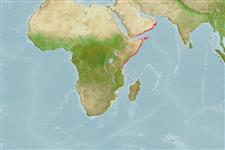Common names from other countries
>
Kurtiformes (Nurseryfishes, cardinalfishes.) >
Apogonidae (Cardinalfishes) > Apogoninae
Etymology: Taeniamia: Name from feminine Latin noun 'taenia' meaning ribbon or band; and feminine Greek noun 'Amia' meaning a fish, often used with cardinalfishes genera. Here as Taeniamia referring to the vertical wide bars and near vertical to curved narrow bars as lines on most of the species in this genus.; pallida: From the Latin word for pale, in reference to its whitish appearance (Ref. 40892).
More on authors: Gon & Randall.
Environment: milieu / climate zone / depth range / distribution range
Ecología
marino asociado a arrecife; rango de profundidad ? - 12 m (Ref. 11441). Tropical
Distribución
Países | Áreas FAO | Ecosistemas | Ocurrencias, apariciones | Point map | Introducciones | Faunafri
Western Indian Ocean: known only from the east side of Masirah Island, off central Oman.
Tamaño / Peso / Age
Maturity: Lm ? range ? - ? cm
Max length : 4.0 cm TL macho / no sexado; (Ref. 11441)
Short description
Claves de identificación | Morfología | Morfometría
Espinas dorsales (total) : 7; Radios blandos dorsales (total) : 9; Espinas anales: 2; Radios blandos anales: 13 - 14. Diagnosis: Rays: dorsal VI + I,9; anal II,13-14; pectoral rays 14 (rarely 15). Gill rakers 5-6 + 13-15. Lateral-line scales 25+3. Median predorsal scales 5-6. Body depth 2.95-3.1 in SL; body width 2.2-2.4 in body depth; eye diameter 3.2-3.5 in head length; first dorsal spine 1.6-1.9 in second spine; second dorsal spine 2.5-2.7, and third dorsal spine 2.5-2.8 in head length; spine of second dorsal fin 2.2-2.6, and second anal spine 2.7-2.9 in head length; pelvic-fin length 4.8-5.2; caudal-peduncle length 4.1-4.9 in SL. Posterior preopercular edge serrate on lower half; ventral edge serrate on posterior half. Scaly sheath along anal-fin base poorly developed or absent (Ref. 54391).
Life cycle and mating behavior
Maturities | Reproducción | Spawnings | Egg(s) | Fecundities | Larva
Are mouthbrooders (Ref. 240). Distinct pairing during courtship and spawning (Ref. 205).
Gon, O. and J.E. Randall, 2003. Revision of the Indo-Pacific cardinalfish genus Archamia (Perciformes: Apogonidae), with description of a new species. Indo-Pac. Fish. (35):49 p. (Ref. 54391)
IUCN Red List Status (Ref. 130435)
CITES (Ref. 128078)
Not Evaluated
Threat to humans
Harmless
Human uses
Herramientas
Special reports
Download XML
Fuentes de Internet
Estimates based on models
Preferred temperature (Ref.
115969): 26.2 - 28.5, mean 27.1 (based on 351 cells).
Phylogenetic diversity index (Ref.
82804): PD
50 = 0.5001 [Uniqueness, from 0.5 = low to 2.0 = high].
Bayesian length-weight: a=0.01122 (0.00528 - 0.02384), b=3.10 (2.92 - 3.28), in cm Total Length, based on LWR estimates for this (Sub)family-body shape (Ref.
93245).
Nivel trófico (Ref.
69278): 3.2 ±0.5 se; based on size and trophs of closest relatives
Resiliencia (Ref.
120179): Alto, población duplicada en un tiempo mínimo inferior a 15 meses (Preliminary K or Fecundity.).
Fishing Vulnerability (Ref.
59153): Low vulnerability (10 of 100).
